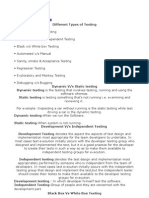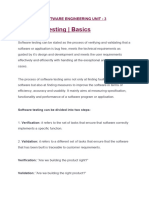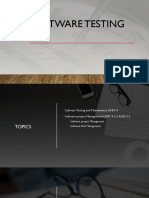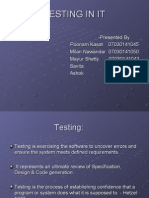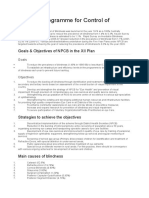0 ratings0% found this document useful (0 votes)
4 viewsTesting
Testing
Uploaded by
Shomirul Hayder SourovThe document discusses various software testing strategies and methods. It describes unit testing, integration testing, validation testing, and system testing which are part of the software testing spiral. It also discusses verification vs validation, smoke testing, regression testing, alpha and beta testing, black box testing and white box testing. The goal of different testing strategies is to ensure software is built correctly and meets customer requirements.
Copyright:
© All Rights Reserved
Available Formats
Download as PDF, TXT or read online from Scribd
Testing
Testing
Uploaded by
Shomirul Hayder Sourov0 ratings0% found this document useful (0 votes)
4 views24 pagesThe document discusses various software testing strategies and methods. It describes unit testing, integration testing, validation testing, and system testing which are part of the software testing spiral. It also discusses verification vs validation, smoke testing, regression testing, alpha and beta testing, black box testing and white box testing. The goal of different testing strategies is to ensure software is built correctly and meets customer requirements.
Copyright
© © All Rights Reserved
Available Formats
PDF, TXT or read online from Scribd
Share this document
Did you find this document useful?
Is this content inappropriate?
The document discusses various software testing strategies and methods. It describes unit testing, integration testing, validation testing, and system testing which are part of the software testing spiral. It also discusses verification vs validation, smoke testing, regression testing, alpha and beta testing, black box testing and white box testing. The goal of different testing strategies is to ensure software is built correctly and meets customer requirements.
Copyright:
© All Rights Reserved
Available Formats
Download as PDF, TXT or read online from Scribd
Download as pdf or txt
0 ratings0% found this document useful (0 votes)
4 views24 pagesTesting
Testing
Uploaded by
Shomirul Hayder SourovThe document discusses various software testing strategies and methods. It describes unit testing, integration testing, validation testing, and system testing which are part of the software testing spiral. It also discusses verification vs validation, smoke testing, regression testing, alpha and beta testing, black box testing and white box testing. The goal of different testing strategies is to ensure software is built correctly and meets customer requirements.
Copyright:
© All Rights Reserved
Available Formats
Download as PDF, TXT or read online from Scribd
Download as pdf or txt
You are on page 1of 24
Six Sigma
Verification and Validation (V&V)
• Verification: “Are we building the product right?”
• Validation: “Are we building the right product?”
• Verification refers to the set of tasks that ensure that
software correctly implements a specific function.
• Validation refers to a different set of tasks that ensure
that the software that has been built is traceable to
customer requirements.
Software Testing Strategy
Software Testing Strategy
• Unit testing begins at the vortex of the spiral and concentrates
on each unit of the software as implemented in source code.
• Integration testing where the focus is on design and the
construction of the software architecture.
• Taking another turn outward on the spiral, encounters
validation testing, where requirements established as part of
requirements modeling are validated against the software that
has been constructed.
• Finally, you arrive at system testing, where the software and
other system elements are tested as a whole.
Software Testing Strategy
Unit Testing
• Unit testing focuses verification effort on the smallest unit of
software design—the software component or module.
• The unit test focuses on the internal processing logic and data
structures within the boundaries of a component.
• This type of testing can be conducted in parallel for multiple
components.
• The purpose is to validate that each unit of the software
performs as designed.
• A unit is the smallest testable part of any software. It usually
has one or a few inputs and usually a single output.
Unit-test considerations
Integration Testing
• Integration testing is a systematic technique for constructing
the software architecture while at the same time conducting
tests to uncover errors associated with interfacing.
• Avoid “big bang” approach - All components are combined in
• advance. The entire program is tested as a whole.
Regression Testing
• Regression testing is the process of testing changes to
computer programs to make sure that the older programming
still works with the new changes.
• Regression tests are performed whenever anything has been
changed in the system, in order to check that no new bugs
have been introduced
Smoke Testing
• Smoke testing came to software testing from a similar
hardware test -where the device passed if it did not catch fire
(or smoked) the first time it was turned on!
• It is designed as a pacing mechanism for time-critical projects,
allowing the software team to assess the project on a frequent
basis.
• commonly used when
product software is developed
Smoke Testing Benefits
• Integration risk is minimized:
– Conducted daily,
– Incompatibilities and other show-stopper errors are
uncovered early
– reducing the likelihood of serious schedule impact when
errors are uncovered.
• The quality of the end product is improved
• Error diagnosis and correction are simplified.
• Progress is easier to assess
• Differences between
– Smoke testing and Regression testing
– Unit testing and Integration testing
– Integration testing and Regression testing
Alpha and Beta Testing
• It is virtually impossible for a software developer to
foresee how the customer will really use a program.
• When custom software is built for one customer, a series
of acceptance tests are conducted to enable the customer
to validate all requirements.
• In fact, acceptance testing can be conducted over a period
of weeks or months, thereby uncovering cumulative
errors that might degrade the system over time.
Alpha and Beta Testing
• If software is developed as a product to be used by
many customers, it is impractical to perform formal
acceptance tests with each one.
• Most software product builders use a process called
alpha and beta testing to uncover errors that only the
end user seems able to find.
Alpha and Beta Testing
• The alpha test is conducted at the developer’s site by
a representative group of end users.
• The software is used in a natural setting with the
developer “looking over the shoulder” of the users
and recording errors and usage problems.
• Alpha tests are conducted in a controlled
environment.
Alpha and Beta Testing
• The beta test is conducted at one or more end-user
sites.
• Unlike alpha testing, the developer generally is not
present.
• Therefore, the beta test is a “live” application of the
software in an environment that cannot be controlled
by the developer. customer base.
Alpha and Beta Testing
• The customer records all problems (real or imagined)
that are encountered during beta testing and reports
these to the developer at regular intervals.
• As a result of problems reported during beta tests,
you make modifications and then prepare for release
of the software product to the entire customer base.
Software Testing Methods
Any software product can be tested in one of two ways:
-Black-box testing
-White-box testing
Black-box testing
• Black-box testing is conducted at the software interface
• A black-box test examines some fundamental aspect of
a system with little regard for the internal logical
structure of the software.
• Black-box tests are used to demonstrate that software
functions are operational, that input is properly
accepted and output is correctly produced, and that the
integrity of external information (e.g., a database) is
maintained.
Black-box testing
• Black-box testing, also called behavioral
testing, focuses on the functional requirements
of the software.
• Black box testing enables the software
engineer to derive sets of input conditions that
will fully exercise all functional requirements
for a program.
Black-box testing
• Black-box testing is not an alternative to white -box
techniques. Rather, it is a complementary approach that
is likely to uncover a different class of errors than
white-box methods.
• Black-box testing attempts to find errors in the
following categories:
(1) incorrect or missing functions,
(2) interface errors,
(3) errors in external data base access,
(4) behavior or performance errors, and
(5) initialization and termination errors.
Black-box testing
• Advantages and disadvantages:
• The black box tester has no "bonds" with the code, and a
tester's perception is very simple: a code must have bugs.
Using the principle, black box testers find bugs where
programmers do not.
• But, on the other hand, because the tester doesn't know how
the software(being tested) was actually constructed. As a
result, there are situations when
(1) A tester writes many test cases to check something that
could have been tested by only one test case, and/or
(2) Some parts of the back-end are not tested at all.
White-box testing
• White-box testing of software is predicated on close
examination of procedural detail.
• Logical paths through the software are tested by providing
test cases that exercise specific sets of conditions and/or
loops.
• white -box testing would lead to "100 percent correct
programs."
• All we need do is define all logical paths, develop test
cases to exercise them, and evaluate results.
White-box testing
Using white-box testing methods, the software
engineer can derive test cases that
• guarantee that all independent paths within a module
have been exercised at least once
• exercise all logical decisions on their true and false
sides
• execute all loops at their boundaries and within their
operational bounds, and
• exercise internal data structures to ensure their validity.
You might also like
- Olympus C-740 Manual User Guide and SpecificationDocument12 pagesOlympus C-740 Manual User Guide and Specificationomni007900No ratings yet
- Cyber Cafe WBSDocument1 pageCyber Cafe WBSapi-3696330100% (2)
- Itsimm-8th - Errata - v2 BICSI 2022Document3 pagesItsimm-8th - Errata - v2 BICSI 2022afouda0% (1)
- 01 - Manual Testing InterView Questions and AnswersDocument25 pages01 - Manual Testing InterView Questions and AnswersSiri Vulisetty100% (1)
- ISTQB Certified Tester Foundation Level Practice Exam QuestionsFrom EverandISTQB Certified Tester Foundation Level Practice Exam QuestionsRating: 5 out of 5 stars5/5 (1)
- Automated Software Testing Interview Questions You'll Most Likely Be AskedFrom EverandAutomated Software Testing Interview Questions You'll Most Likely Be AskedNo ratings yet
- Eddy CurrentDocument19 pagesEddy CurrentSreedhar Patnaik.M100% (3)
- F 233 BPD Repetitive Manufacturing With Supply Into ProductionDocument33 pagesF 233 BPD Repetitive Manufacturing With Supply Into ProductionHermenegildo DiazNo ratings yet
- Software Testing: Presented byDocument77 pagesSoftware Testing: Presented byAnupama MukherjeeNo ratings yet
- Se 8Document25 pagesSe 8Abbas RiazNo ratings yet
- UNIT 4 ContentDocument89 pagesUNIT 4 Contentlol2003oloNo ratings yet
- Software Quality and Testing (CSC 4133) : Common Interview QuestionsDocument46 pagesSoftware Quality and Testing (CSC 4133) : Common Interview QuestionsrohanNo ratings yet
- Test and IntegrationDocument28 pagesTest and IntegrationManzu PokharelNo ratings yet
- Software Testing StrategiesDocument29 pagesSoftware Testing StrategiesHamad HussainNo ratings yet
- Software Engineering Week 15 16Document51 pagesSoftware Engineering Week 15 16wkchannaNo ratings yet
- Unit 4 SEDocument86 pagesUnit 4 SEvidyush.2125cse1046No ratings yet
- Software TestingDocument29 pagesSoftware TestingnandiniNo ratings yet
- Lecture 1 IntroductionDocument31 pagesLecture 1 IntroductionSantosh PantaNo ratings yet
- ISE Slide 8Document7 pagesISE Slide 8Amna MushtaqNo ratings yet
- Unit 6 SW TestingDocument49 pagesUnit 6 SW TestingPrasad Patil100% (1)
- Se Unit-5Document61 pagesSe Unit-5richie053No ratings yet
- Ucs1010 Software Testing Question Bank All 5 Units.Document15 pagesUcs1010 Software Testing Question Bank All 5 Units.anusenthil04No ratings yet
- 01.let's Start!Document35 pages01.let's Start!sycb2xktn4No ratings yet
- V ModelDocument30 pagesV Modelpriya dharshiniNo ratings yet
- 6.1. TestingDocument12 pages6.1. TestingshubhamNo ratings yet
- CMP202 Lecture 4 - Program TestingDocument18 pagesCMP202 Lecture 4 - Program TestingAkorede BashirNo ratings yet
- Cse 3 1 Se Unit 6Document10 pagesCse 3 1 Se Unit 6nani peddintiNo ratings yet
- Lec 25Document29 pagesLec 25Faceme TesterNo ratings yet
- Software TestingDocument51 pagesSoftware Testingjeyaseelan100% (19)
- Seng308 CH6Document39 pagesSeng308 CH6arun5918No ratings yet
- Software Testing - JICDocument29 pagesSoftware Testing - JICsiamrahamannirobNo ratings yet
- UNIT 5 Software Testing 1Document35 pagesUNIT 5 Software Testing 1ijantkartanishkaNo ratings yet
- Software TestingDocument10 pagesSoftware Testingsumusumaya164No ratings yet
- 1.software TestingDocument40 pages1.software TestingarunlaldsNo ratings yet
- Dcap 503 2Document51 pagesDcap 503 2Neha DograNo ratings yet
- SE FileDocument12 pagesSE Fileares4006115No ratings yet
- CH - 4 Test Levels and Testing TypesDocument50 pagesCH - 4 Test Levels and Testing TypesUmesh MahajanNo ratings yet
- Lecture 3.3.5 Test StrategiesDocument23 pagesLecture 3.3.5 Test StrategiesSahil GoyalNo ratings yet
- Chapter 9 Testing StrategiesDocument44 pagesChapter 9 Testing StrategiesBhumireddy ChandanaNo ratings yet
- Basic Iphone Application DevelopmentBlock-5Document35 pagesBasic Iphone Application DevelopmentBlock-5solanki.hemaxi21No ratings yet
- Software Testing Fundamentals - Pragati DemannaDocument38 pagesSoftware Testing Fundamentals - Pragati DemannaAsif RanaNo ratings yet
- Activity # 1: Software Testing: Introduction Testing Methods Levels of TestingDocument26 pagesActivity # 1: Software Testing: Introduction Testing Methods Levels of Testingsibhat mequanintNo ratings yet
- Software Testing StrategiesDocument25 pagesSoftware Testing Strategieshabado badoNo ratings yet
- UntitledDocument15 pagesUntitledRajashekar Reddy TalapaNo ratings yet
- Chapter 6Document64 pagesChapter 6Sushant YadavNo ratings yet
- Introduction To Software Quality Assurance & TestingDocument25 pagesIntroduction To Software Quality Assurance & TestingRajarshi PatelNo ratings yet
- Unit 5Document18 pagesUnit 5srikanthNo ratings yet
- Lecture 3.3.1 Software TestabilityDocument17 pagesLecture 3.3.1 Software TestabilitySahil GoyalNo ratings yet
- SE unit-4Document33 pagesSE unit-422wj1a05ahNo ratings yet
- Unit - IV Testing ApplicationDocument19 pagesUnit - IV Testing Applicationsyedzoheb619No ratings yet
- Testing TutorialDocument8 pagesTesting TutorialSapnilNaikNo ratings yet
- Unit 4 Part 1Document44 pagesUnit 4 Part 1maddishiva1989No ratings yet
- Unit 4 SEDocument8 pagesUnit 4 SEAnurag SharmaNo ratings yet
- TestingDocument104 pagesTestingchatterjeesoham2003No ratings yet
- SW_Lecture-08.pptxDocument44 pagesSW_Lecture-08.pptxjobaerislam16No ratings yet
- SE UNIT - 3Document28 pagesSE UNIT - 3kidscorner533No ratings yet
- Software TestingDocument63 pagesSoftware TestingSita kumarNo ratings yet
- Testing in ITDocument21 pagesTesting in ITapi-19916368No ratings yet
- SE Module-IV Testing StrategiesDocument49 pagesSE Module-IV Testing StrategiesAnushaNo ratings yet
- TestingDocument18 pagesTestingmatthewhoulihan87No ratings yet
- Software Testing SefaDocument3 pagesSoftware Testing Sefashahalameenu2003No ratings yet
- TestingDocument13 pagesTestingmohdshoaib0255No ratings yet
- PMIT 6111 Lecture 1 Introduction to SDLCDocument37 pagesPMIT 6111 Lecture 1 Introduction to SDLCsubscribtionbs8755No ratings yet
- SE Unit IVDocument54 pagesSE Unit IVhhariharan.112204No ratings yet
- Moline 1995Document20 pagesMoline 1995CLELIA NARANJO FREIRENo ratings yet
- A Comparative Study On The Preference of Starting Up Traditional or Ecommerce Business of BS Entrepreneurship Students in Ateneo de Davao UniversityDocument38 pagesA Comparative Study On The Preference of Starting Up Traditional or Ecommerce Business of BS Entrepreneurship Students in Ateneo de Davao Universityfloyren valdezNo ratings yet
- Best Albania Property - Lalzi Bay ResortDocument3 pagesBest Albania Property - Lalzi Bay ResortAlbania_EstateNo ratings yet
- Ger 3428a Fuels Flexibility HDGTDocument33 pagesGer 3428a Fuels Flexibility HDGTJosemar LopesNo ratings yet
- Distance Measurement Using Arduino Ultrasonic Sensor - Code & Circuit DiagramDocument6 pagesDistance Measurement Using Arduino Ultrasonic Sensor - Code & Circuit DiagramdewasuryantoNo ratings yet
- PDOHO Clearance 2022Document2 pagesPDOHO Clearance 2022mpdrc52sr7No ratings yet
- 9089 FormDocument15 pages9089 Formdanielwwcheong8981No ratings yet
- Outlook 25may 2020 PDFDocument61 pagesOutlook 25may 2020 PDFmohnishNo ratings yet
- Structure Lab 3Document9 pagesStructure Lab 3DAus Sapar50% (2)
- Huỳnh Tấn Huy Hoàng - BUSI1637 - Final assignmentDocument21 pagesHuỳnh Tấn Huy Hoàng - BUSI1637 - Final assignmentDream HoangNo ratings yet
- National Programme For Control of BlindnessDocument2 pagesNational Programme For Control of BlindnessPintu KumarNo ratings yet
- Structural AnalysisDocument26 pagesStructural Analysisafifa kausar100% (3)
- Ela6000 ManualDocument40 pagesEla6000 ManualĐức QuangNo ratings yet
- 3.introduction toDS - Algorithms - Day3 PDFDocument24 pages3.introduction toDS - Algorithms - Day3 PDFRiham AbdallahNo ratings yet
- Oil - A Historic CollapseDocument5 pagesOil - A Historic CollapseBelajar StatistikNo ratings yet
- Letter To Request For UniformDocument1 pageLetter To Request For UniformJon Resutadesu100% (1)
- Working of Trade Union - HMSDocument13 pagesWorking of Trade Union - HMSShaista NasirNo ratings yet
- Brian Spector Leaving Baupost Letter - Business InsiderDocument4 pagesBrian Spector Leaving Baupost Letter - Business InsiderHedge Fund ConversationsNo ratings yet
- Requests For MED3 Fit Note': Covid-19 Guidance For PracticesDocument2 pagesRequests For MED3 Fit Note': Covid-19 Guidance For Practicesplayjake18No ratings yet
- Econometrics For Finance Assignment 2 2023 12-07-12!14!23Document3 pagesEconometrics For Finance Assignment 2 2023 12-07-12!14!23Binyam Taye100% (1)
- Unit - 1 ReservoirsDocument2 pagesUnit - 1 ReservoirsMansour Controversial KhanNo ratings yet
- Release Notes For Ipp 6.0: Image-Pro Plus 6.0 Has An All-New Ipbasic Editor. This Editor Adds CommandDocument4 pagesRelease Notes For Ipp 6.0: Image-Pro Plus 6.0 Has An All-New Ipbasic Editor. This Editor Adds CommandmaryNo ratings yet
- Slotdrain REINFORCEMENT - DETAILSDocument1 pageSlotdrain REINFORCEMENT - DETAILSSlavisa LukovicNo ratings yet
- Answer Key - Limitation Act - Raj JLODocument6 pagesAnswer Key - Limitation Act - Raj JLOMayank SainiNo ratings yet



















































